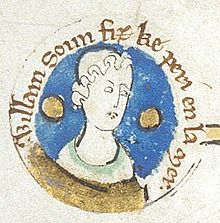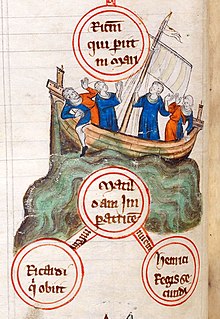William Adelin
| William Adelin | |
|---|---|
| Duke of Normandy | |
 | |
| Born | 5 August 1103 Winchester, Hampshire, England |
| Died | 25 November 1120 (aged 17) near Barfleur, Normandy |
| Spouse | |
| House | Normandy |
| Father | Henry I of England |
| Mother | Matilda of Scotland |
William Ætheling (Middle English: [ˈwiliəm ˈaðəliŋɡ], Old English: [ˈæðeliŋɡ]; 5 August 1103 – 25 November 1120), commonly called Adelin (sometimes Adelinus, Adelingus, A(u)delin or other Latinised Norman-French variants of Ætheling)[a] was the son of Henry I of England by his wife Matilda of Scotland, and was thus heir apparent to the English throne. His early death without issue caused a succession crisis, known in English history as the Anarchy.
Early life
William was born in Winchester. His father, King Henry I of England, had married his mother, Matilda of Scotland, to conciliate his English subjects. Matilda was descended from Edmund Ironside and was a great-niece of Edward the Confessor; as such, the marriage represented a union between the new Norman rulers of England and the old Anglo-Saxon dynasty.
Henry's hopes for his succession rested upon William, who was, according to Henry of Huntingdon, "a prince so pampered" that he seemed "destined to be food for the fire."[1]
Duke of Normandy
During Henry I's lifetime, William was invested as Duke of Normandy, a title he held more in name than in practice. Henry made the investiture when he was pressed by the king of France, Louis VI, to do homage as Duke of Normandy. As a king in his own right, Henry was loath to comply, and in 1115 he offered to have William do this in his stead. This offer was eventually accepted in 1120, after an intervening period of war, and William did homage to Louis VI in the middle of 1120. For this reason William is sometimes counted as Duke of Normandy (as either William III or William IV).[b] William received, as the heir to the throne, the homage and fealty of the barons of Normandy in 1115 and of the barons of England in March 1116.[2]
William's mother Queen Matilda served as Henry's regent in England while he was away in Normandy. After her death in 1118 William was old enough to serve in her stead. He was closely advised in this role by the King's administrators, such as Roger of Salisbury. During the last year or so of his life he was sometimes referred to as rex designatus (king designate).
During his 35-year reign
Death

William died in the
The crew and passengers could not lever the ship off the rock, or prevent the ship from filling with water. William and several of his friends managed to launch a life-dinghy. At the last minute, William dashed back to rescue his illegitimate half-sister, Matilda FitzRoy, Countess of Perche. When they and several others threw themselves into the small dinghy, it, "overcharged by the multitude that leapt into her, capsized and sank and buried all indiscriminately in the deep."[1]
Notes
- ISBN 0-631-22492-0..
- ^ William Clito, son of Robert Curthose and William's first cousin, is also sometimes designated 'Duke of Normandy'.
References
- ^ a b c d Meade 1991.
- ^ doi:10.1093/ref:odnb/29453. (Subscription or UK public library membershiprequired.)
Bibliography
- Meade, Marion (November 1991). Eleanor of Aquitaine. Penguin. ISBN 9781101173930.
- . Dictionary of National Biography. London: Smith, Elder & Co. 1885–1900.
Further reading
- Hollister, C. Warren (January 2001). Henry I. Yale Monarchs Series. ISBN 0300098294.
